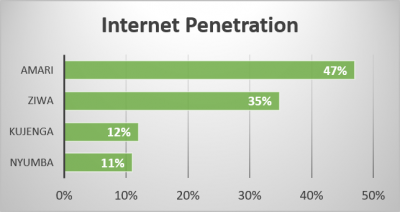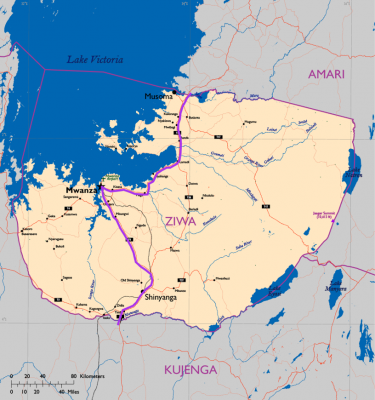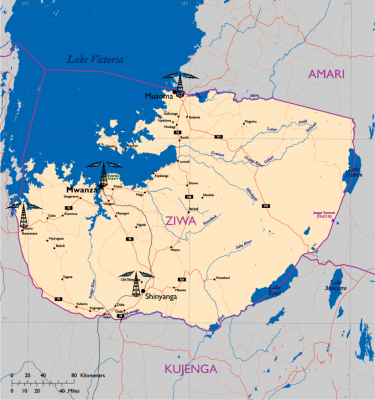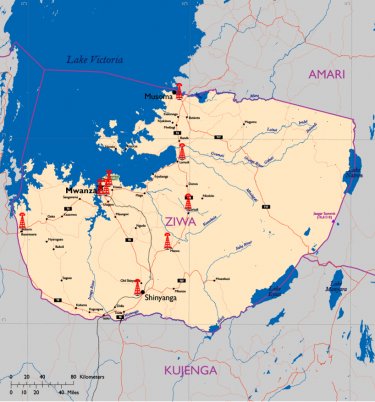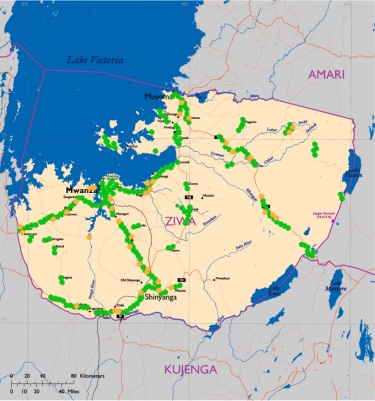Information: Ziwa
Ziwa’s information sharing and management is very progressive. The government and population seize on the opportunities that technological advancement offers to enhance the quality of life. Some 15 years ago, the government instituted the Ziwa Institute of Science and Technology Management (ZISTM) to direct the development of information technology. ZISTM actively conducts Information, Communications, and Technology (ICT) programs to achieve the goal of developing the most enhanced information management country in Africa. Government programs support many sectors, including government regulatory support, science and technology education, business, and technology development and implementation. ZISTM established and maintains the country’s social media presence using the applications popular not only with Ziwa’s population but also with the region at large.
Government regulatory action resulted in reforms to the Telecommunications Act. These reforms officially abolished government censorship of Internet news and information sharing. In addition, passage of laws supporting e-commerce and digital signatures contributed to one of the most active e-government and e-commerce sectors in Africa.
The government, working with the business sector, launched initiatives to develop the country’s mobile service network as rapidly as possible. Ziwa successfully implemented a 3G mobile broadband service despite the lack of intervening 2G infrastructure. The government was able to institute this advanced communication technology while supporting development by private network providers.
Recent government support and testing of mesh network systems granted Internet access to the majority of Ziwa’s population. Implementation of mesh networks throughout the country also improved internet security thanks to the system’s embedded network security hardware and firmware.
Low-cost data packages and mobile phones are quickly becoming ubiquitous throughout the country. The government’s emphasis and support of connectivity puts the country on-pace to surpass Amari as the leading internet and mobile phone using country on the continent.
Satellite Telecommunications
Ziwa continues a successful program developing space-based support of security and information management goals. Through the Raptor program, the government entered into contracts for the production of multiple satellites to support geospatial imagery and mapping collection, electronic intercept, and telecommunication.
Ziwa recently entered into contracts with satellite manufacturer Du'Ralle, and launch services company EuroSpace, for its latest series of satellites. Satellites launched by EuroSpace under contract with the Ziwan government established required baseline geospatial imagery and telecommunications capabilities. Ziwan engineers work in conjunction with Du’Ralle to ensure quality control of all required platform capabilities and to gain expertise used to build organic production knowledge.
EuroSpace launches payloads from its complex in South America while Ziwan technical staff performs ground control operations from the EuroSpace control station. A new satellite control complex is under construction in Igombe, where the government plans to assume full control of all satellite platforms. The objective is to build and operate an indigenous satellite fleet.
Ziwa uses GPS navigation in support of many programs. Notable among them is the long-running effort to reduce the tik-tik (Tsetse) fly population found along the shore of Lake Victoria. Tik-tik fly infestations occur throughout the African continent; the Sub-Sahara area immediately around Lake Victoria is one of the largest. The fly transmits sleeping sickness to humans through its blood sucking bite, and causes a similar disease in livestock. The human and agricultural impact of this pest is significant, but the use of GPS to direct aerial spraying techniques reduced the infestation to a manageable level. GPS navigation is essential to the program as it ensures control of the sequence of spray blocks and navigation overlap. The military also uses the mission as a training mechanism to establish and maintain the capability to deliver biological or chemical agents.
Ziwa military forces currently use the Global Navigation Satellite System (GNSS) for guidance and limited targeting. The government continues to work with the European Space Agency (ESA) as a partner in the group focused on deployment of the European Geostationary Navigation Overlay Service (EGNOS) by 2020. EGNOS upgrades will improve signal reliability, thereby reducing susceptibility to spoofing or jamming.
Public Communications Media
Ziwa Telecommunications (ZT) is a government monopoly operating the country’s communication networks, internet, radio, television, and telephone. Though government controls radio, television and the internet, this control does not translate to censorship, based on the laws passed in 2013. The government initiated reform of the country's Telecommunications Act in 2013 and resulted in an official prohibition of government internet censorship. Courts maintain oversight to ensure that any attempts at government censorship are quickly resolved. In addition, the government passed laws supporting e-commerce and digital signatures that lead to one of the most active e-government and e-commerce sectors in Africa. Courts quickly adjudicate any infringement on the right of free speech or instances of government overstepping the limits of prosecutions allowed by law.
Print media continues to be a strong source of information for the Ziwan public. There are 23 daily newspapers and over 500 weekly or monthly newspapers and periodicals. Newspapers routinely criticize all levels of the Ziwan government, as well as other countries. The government has arrested journalists who refused to provide information on their sources. The courts, however, predictably free them once the case comes to trial. Word-of-mouth also remains a well-used information channel, strongest in religious groups, trade unions, and tribal conduits.
Internet
Ziwa’s general population is rapidly becoming technically adept, with a growing interest in the opportunities offered by electronic financial transfers, social media, and data mining. The growth of 3G broadband cellular availability and dropping costs of data packages is responsible rapid growth in internet use by Ziwans. The last statistics available show the internet penetration rate at 35% with a projected growth rate of 10% annually. This growth and penetration percentage puts Ziwa on par with or surpassing that of Amari.
Using submarine internet cables and an expanding fiber-optic backbone network, there are a dozen public and private ISPs competing in the communications business sector. The terminus for the submarine cables is located in Kujenga, with the internet backbone transiting to Ziwa thru Amari and Kujenga. This arrangement generally provides reliable service, but some interruptions occurred when Kujengan fishing vessels and container ships operating in coastal waters cut the cables by accident. The outages corresponded to conflict between Kujenga and Ziwa over economic and border-control agreements. This situation was the impetus for Ziwa to pursue development of space-based Internet and telecommunications service solely under control of the Ziwan government.
The rapid growth of internet use in Ziwa provides a platform for an increasing number of social media celebrities. Using blogs, vlogs, and individual web sites, these celebrities are branching out to influence public opinion in a variety of areas.
A recent example is a group of notable soccer players and government leaders, who launched a social media campaign to popularize the government’s program to eradicate malaria in regions bordering Lake Victoria. Ziwa experiences 4 to 5 million malaria cases each year and as many as 20,000 deaths, mainly children. The campaign was a resounding success, with donations of $270,000 dollars to purchase mosquito netting and to deliver public information to prevent malaria conditions in affected towns and villages.
Other public figures are taking note of such successes, and consequently trying to increase their own online presence using popular applications that are readily available to the public. The government noted the potential advantages of a social media presence and uses the internet to influence public opinion in its favor wherever possible.
Television
Television remains a leading media product, with access found in 92% of the current households. Broadcast facilities and transmitters remain under government control and service two national and one private network. The networks support a chain of 26 stations throughout the country, with an estimated number of over 2 million TV sets. Private network broadcasts provide separate entertainment focused mostly on sports and variety shows. The viewing public also has direct access to regional and international satellite television programming.
Radio
Ziwa Telecommunications (ZT) operates the broadcast system for 3 national radio networks, 27 regional radio stations and 3 privately owned stations. All report the national and regional news from the Ziwa news agency, with international news stories covered in more detail by the private stations.
A confluence of two media technologies, radio and internet, birthed a new online radio station to serve the LGBT community in Ziwa. Based in the capital of Mwanza, the station serves the community by providing programming that sensitizes the public to political, economic, and social issues as they relate to the LGBT movement. The Hadhi Group launched the station and its programming after successfully pushing legislation through parliament that mandates equality and tolerance of all gender perspectives. This is a significant departure from the previous status of the LGBT community in Ziwa where homosexual activity was illegal. The change in the law and the establishment of the station met with violent opposition from some segments of the population and immediate condemnation from Kujenga and Nyumba.
PLACEHOLDER FOR RADIO BROADCAST GRAPHIC
Print Media
Print media continues its historic role in Ziwa as a bastion of truth. Publishers and journalists hold an ethos that they seek and report facts and not opinion, even when unpopular with the government. The Ziwan people hold print media in high regard and readily launch demonstrations calling for journalist release when incarcerated for political reporting.
Journalists in Ziwa are embracing digital channels for information delivery to the public. The Ziwan public, trusting journalist ethics, treat the new media channels as totally honest reporting. They value and respond to calls from publishing houses to counter perceived government infractions.
PLACEHOLDER FOR HANDBILL GRAPHIC
Telephone
Ziwa followed the same path as many other countries in Africa and jumped directly to mobile phone service, bypassing landlines as the main communications means. ZISTM initiated the program for commercial 3G/LTE licenses for mobile service, with Yellow, an international commercial provider, announcing in February 2013 that it intended to offer the service. Zalu and Upanga, both service providers, followed respectively with their own announcements in July and November 2013. In March 2014, the ZISTM regulators accepted bids from all three Multi-National Communication Consortiums (MNCCs) for 3G/LTE licenses. The companies conducted extensive system trials in late 2014 and early 2015, with commercial launches made in late 2015. The mobile 3G/LTE market skyrocketed after the initial offering to reach a subscription rate of 763 per 1000 of the population to-date. The subscriber rate continues to grow as the service providers expand the infrastructure to support their networks.
Yellow and Upanga were licensed as fixed-line operators prior to offering 3G/LTE service. Subsequent to the 3G/LTE rollout they added DSL and Fiber-to-the-Premises (FttP) services in 2016. Both companies experienced some market shrinkage in the fixed-line market as consumers switched to wireless phone and internet service.
The rapid expansion of mobile phone use is made possible by the availability of prepaid Subscriber Identity Module (SIM) cards. Initially, the government required little in the way of documentation of SIM card sales, creating a huge market of small SIM card sellers to appear throughout the country. As it became apparent that limited regulation would lead to misuse and abuse, SIM registration requirements were established. In May 2015, a mandatory registration program went into effect to capture and document identification information of all paid and prepaid SIM card users. The program instituted a one-month grace period with a cut-off date for completion of registration. After that date, the government forced all mobile service providers in Ziwa to cut-off service to unregistered SIM cards.
While the intent of the program was to reduce fraud and crime associated with unregistered SIM cards, it actually had several negative effects. First and foremost, there were many users that were unceremoniously cut-off because of poor program administration. This resulted in lengthy adjudication and a growing public anger. Public outcry lead to distrust over security of user information and the government’s access. Finally, the program caused a black market to spring up for purchase of fraudulently-registered or stolen SIM cards. Criminal elements in Ziwa found the black market to be lucrative in both the sale of the SIM cards and identity theft.
The mobile phone market is expected to show double-digit growth over the next 5 years. The public is rapidly dropping their hard-wired phones to adopt low-cost mobile units supplied by both international and national service providers. The activation of Ziwan satellite service supporting Internet access will result in increased competition and is expected to reduce the cost of access by as much as 60%. The situation is a point of contention with Kujenga, who currently controls Internet access to Ziwa over the undersea cable. The last data available from 2015 indicated the mobile penetration of the Ziwa population at 57% and based on the growth projections, the percentage is estimated to be 77% or higher.
PLACEHOLDER FOR MOBILE PHONE POPULATION GRAPHIC
Postal/Courier
Just as in other African countries, Ziwa’s postal system offers not only letter and package delivery but also financial services. At the onset of mobile phone growth, there were approximately 4 million Ziwans with bank accounts through their local post office. Integration of e-finance services via mobile phones resulted in significant growth of on-line accounts—almost 6 million to-date.
The ability to reach 2 million additional Ziwans was possible due to the extensive rural infrastructure of the postal system. Approximately 117 post offices provide this network. Ziwa Post (ZP) integrated electronic bank services provide cash transfers, bill payment, and short-term loans.
ZP is a relatively reliable service provider with a good track record of delivery and accountability. Public perception is that the postal service is a trustworthy government agency and there is little corruption among the postal employees. The government’s direct investment to establish the necessary network connections focused on reliability and security firmly establishes ZP as a key information service provider for the population.
Word of Mouth
Among many families and tribes in Ziwa, Word-of-Mouth (WoM) is still the most trusted information medium. Ziwans, however, are quickly assimilating new communication abilities offered by the internet and mobile phone technology, and WoM is starting to lose its standing in information exchange. Ziwans now have greater access to information, with many accepting internet content without question of the validity. Some pockets within the country continue to rely on WoM; the strongest are religious groups, trade unions, and tribal groups.
Information Control
Government control of radio, television and internet continues with a strong focus on using the full capabilities of the various Information Communications Technologies (ICTs) to advance Ziwa’s economy as rapidly as possible. Compliance by government leaders with the country’s anti-censorship laws continues to be effective in maintaining the guaranteed freedom of speech established by the constitution.
ZT regulates the ICT sector to maintain Ziwa’s reputation as one of the most liberal ICT markets in Africa. ZT continues to sponsor the rapid development of the ICT sector, primarily by means of spreading high-speed internet access for all Ziwans. Challenges of adequate funding and environment have slowed the development process, but steady progress continues with the adoption of new technology and methods of establishing the required networks.
One of the government’s highest priorities is to establish full internet network connectivity through domestically controlled systems. This priority drives the development of the Ziwa satellite fleet to provide uninterruptible access. The interruption of network connectivity over the land-based internet trunk line from Kujenga is a strong motivator for the government’s program.
In several instances, interruption of network connections through Kujenga caused losses to Ziwan banks and other financial institutions. Kujenga attributes the interruptions to fishing vessels hitting the submarine communications cable that services Kujenga and ultimately Ziwa. Kujenga often fails to provide any projection of the length of repairs; some outages extend for several weeks.
INFOWAR
Ziwa’s leadership continues to control and direct INFOWAR (IW) assets at the national level. Unit, equipment, and personnel allocations are under the direction of the national command authority to ensure compliance with national objectives. Resource allocation is for a specific period, with dual reporting to both the supported unit and the national command authority. In this way, the leadership remains aware of all collection efforts as well as the intended effects on the identified targets.
Electronic Warfare
Electronic warfare (EW) capabilities consist of integrated radar warning and RF countermeasures. The EW platforms consist of under-wing pods attached to the limited number of aircraft in the Ziwan Air Corps. The pod provides the pilot with real-time situational awareness and detection of surface-to-air and air-to-air radar guidance. The system’s integrated threat warning and electronic countermeasures automatically identify threat radar systems for targeting by on-board aircraft weapons.
Computer Attack
The leadership of Ziwa, recognizing the growing potential of cyber warfare, created a new government group in 2010 to develop the skills and techniques necessary target adversary computer systems. The government chartered the Ziwa Automation Emergency Response Organization (ZAERO) to build the required capabilities. Initially, ZAERO focused primarily on defensive cyber methods to protect government, military, and financial systems. As defensive capabilities came on-line, the group turned its focus to offensive cyber. An understanding of the typical defensive measures used to protect computer systems and networks provided insight into how to best attack adversary systems.
ZAERO maintains an active recruitment office to recruit technical expertise found within Ziwa, as well as international sources such as from North Torbia. After completing their training, North Torbian hackers deploy throughout the world to launch attacks where countries will pay for cyber services and training. The cyber cadre conducts operations such as reconnaissance, sabotage and criminal activities. Computer attacks launched by North Torbia hackers operating for Ziwa allowed for minimal operational risk, while at the same time allowing the Torbians to generate much needed revenue.
The growing world attention caused by North Torbia’s conflict with the West caused Ziwan leadership to reconsider its relationship with the country. Ziwa, having gained knowledge and expertise from the North Torbia group, is now systematically breaking ties with the country.
Information Attack
Training by the North Torbian hackers-for-hire created the opportunity for Ziwa’s leaders to develop a policy of relying on information attacks as the first response to threats. Exploitation of the growing information and communications technology (ICT) use in Africa allows Ziwa to develop new and innovative methods of exploiting data of potential opponents. Ziwa targets not only the expected financial, infrastructure, and government networks, but also prioritizes penetration of social media networks, recognizing them as a conduit to exploit more critical targets. This approach provides deniability and is forensically difficult for target countries to prove without extensive cyber capabilities. The information attack program also links with active deception to create doubt within adversary countries of the information’s validity.
Deception
ZAERO also developed the capability to construct false or misleading messages and internet traffic to support government information campaigns. Using misinformation, Ziwa builds a storyline that deceives the target audience for the benefit of the country. The group uses all forms of media to create audio, video, internet news posts, social media posts, and even graphic posters that serve to change the public’s or an adversaries understanding of reality.
Social media use throughout Africa continues to grow rapidly: latest research reports indicate as much as 20% growth in internet penetration in the past year. Correspondingly, the use of social media applications such as WhatsApp and Facebook Messenger has also grown significantly. Law and user experience to protect against false or misleading messages, however, is lagging behind this rapid growth. Enacting new laws to counter deceptive practices is a double-edged sword for all African governments, including Ziwa. While ostensibly intended to deter illegal activities, new laws and regulations established by the government can easily be misused to repress or silence dissent.
Physical Destruction
Ziwan doctrine targets the command and control (C2) systems and leadership of the opposition. The Ziwa government and military are pursuing a program that links drones and social networking capabilities to target C2. The VULTURE program created a system composed of swarming coordinated drones that targets leaders using information gathered from social media sources. Drone swarms are air or ground deployable, with long-loiter characteristics due to advanced battery technology and small but lethal munitions. The swarm deploys to sites frequented by the target, then goes into loiter mode until receiving an attack signal. Upon confirmation, the coordinated swarm launches to attack the target with as many repeated strikes as there are drones in the swarm.
Using this technology, Ziwa avoids the expense involved of a large standing army. Intelligence collection using HUMINT, IMINT, OSINT, and SIGINT collects the information necessary to build the target profile to the point needed to allow discriminatory targeting. Drone swarm delivery is possible using multiple systems: vehicle, HUMINT agent, commercial delivery such as DHL, aircraft, or missile. Delivery system selection depends on the number of drones deemed necessary for the strike mission.
Protection and Security Measures
The leadership of Ziwa, recognizing the cyber threat, instituted in-depth security procedures to protect government, military, and financial systems. The government organized the Ziwa Automation Emergency Response Organization (ZAERO) in 2010 to identify the threats to the growing national Internet networks and to develop a program to institute adequate protection measures. ZAERO developed a three-part program to establish a network protection program. The first actions were to establish an adequate legal basis to allow government protection of the networks while still maintaining guaranteed freedoms. Second, they launched a program focused on creating awareness of the computer, internet, and network threats with the population. Third, ZAERO undertook a program to create in-country expertise using Ziwa’s educational system to counter the threats instead of relying on hackers from North Torbia.
ZAERO works with higher education and the training community to recruit and develop individuals with the skills and talent needed to secure Ziwa’s computers and networks. The program implemented a Master’s program in Information and IT Security in 2012. That program subsequently produced 24 Master’s graduates that work in the government, military, and business sectors. The strength of the program serves as the basis for the military development of both defensive and offensive computer warfare capabilities.
Ziwa is working to expand the program’s reach by developing regional support for computer and network security. Ziwa and Amari signed a mutual support agreement, with Ziwa taking the lead in providing technical expertise for IT protection and security measures. The regional office for computer and network protection is the lead agency in identifying threats attacking the financial sectors of both countries and in taking action to defend critical financial institutions by removing the threats.
Perception Management
Rapid growth of internet access in Ziwa created social media celebrities that have the ability to shape public perceptions. The government attempts to use their popularity to sway public perception with some limited success. The use of social media as the most popular media of the moment is the most effective way of reaching the population with the government message. Rather than the intended outcome of supporting government programs, the main result has been to increase the popularity of the social media personalities.
The government still relies on print, radio, and television as means to target messages to selected portions of the population. Using multiple means of message presentation leads to some instances of conflicting information and confused public perceptions. New programs are exploring the use of social media to aid the government in economic and information development.
Intelligence
Ziwa maintains a centralized intelligence organization and allocates assets to military, security, or national missions based on analyzed requirements.
Command and Control Systems
Government
- Networks – Existing cellular and internet networks; developing secure satellite linked replacements
- Radar – Principally support for commercial aviation operations
- Optical – Airborne platforms with video and thermal cameras. Satellite imagery capability coming on-line in the near future.
- Satellite – Purchased services for communications and imagery with government-owned platforms coming online.
Military
- Networks – Encrypted version of mesh-net networks that supports secure VOIP.
- Radar – integrated radar warning; limited ground systems
- Radio – HF, VHF, UHF; Land Mobile Radio,
Human Intelligence
Human intelligence continues to provide the majority of external data collection and a balanced share of internal intelligence for the Ziwa government. Internally and internationally, Ziwa recruits technicians working in oil and gas field operations. These agents target information collection that identifies potential fields, production capacities, and development plans. Many of the Ziwa agents are in the information technology, technical support, and mid-level managers operating Amari, Kujenga, and other African competitors.
At the national level, the government routinely deploys special purpose forces to locate and target the activities of insurgents and other disruptive groups such as criminal gangs. Special purpose forces perform missions that collect essential intelligence to allow the military to launch raids and target patrols of suspected insurgent areas or smuggling routes. An agent network in each of the largest Ziwan tribes provides a steady flow of information from the field that allows the Ziwa Intelligence Service to identify individuals and groups that are potential threats to national objectives.
Open Source Intelligence
Ziwa is rapidly adopting open source information research and analysis to improve intelligence capabilities with the assistance of the Ziwan education sector. The Ziwa computer exploitation, research, and technical (ZCERT) team forms the core of the open source intelligence operation. ZCERT monitors all public network traffic and information sources to identify potential exploitation opportunities or threats to national interests. As part of the development of OSINT capabilities, ZCERT has several R&D projects to explore the use of data-mining, artificial intelligence, and social media applications.
Signals Intelligence
Ziwa uses proven network surveillance capabilities as part of its signals intelligence operation. Coupling FinSpy malware with man-in-the-middle ISP uploads Ziwa SIGINT is capable of gathering information from infected computers and smartphones. The offensive cyber capability allows Ziwa to target internet users in Amari, Kujenga, Nyumba or other countries to collect intelligence information. The software uses advanced techniques to avoid detection by antivirus software or forensic techniques that identify the source of the attack.
Imagery Intelligence
The design of the Ziwa satellite fleet provides high-resolution imagery of internal and external activities. Analysts estimate that the latest satellite has a High Resolution Imager (HiRI) with the capability to achieve resolution of 70 centimeters (28 inches). The configuration also includes an improved communication package designed to provide data downlink but also to link the country’s mesh web network to expand internet coverage. The scheduled launch of the 1,100-kilogram (2,420 lb.) satellite is set for March 2018 from Guiana Space Centre – located near Kourou in French Guiana.
Measurement and Signatures Intelligence
Ziwa has no established MASINT systems.
Summary
Ziwa’s information domain continues rapidly expanding with the aid of government and private support. Seeking to gain the maximum advantage from adoption of new technologies, Ziwa is gaining the economic benefit of improved efficiency and global recognition as an up-and-coming country. The government is using the latest technology to improve the population’s standard of living while maintaining regional security. Information media remain under the control of the government that seeks to establish a protected environment using active monitoring to detect any censorship or limits on message traffic. Strong legal and legislative systems maintain active checks against government censorship and abuse of the information environment.

